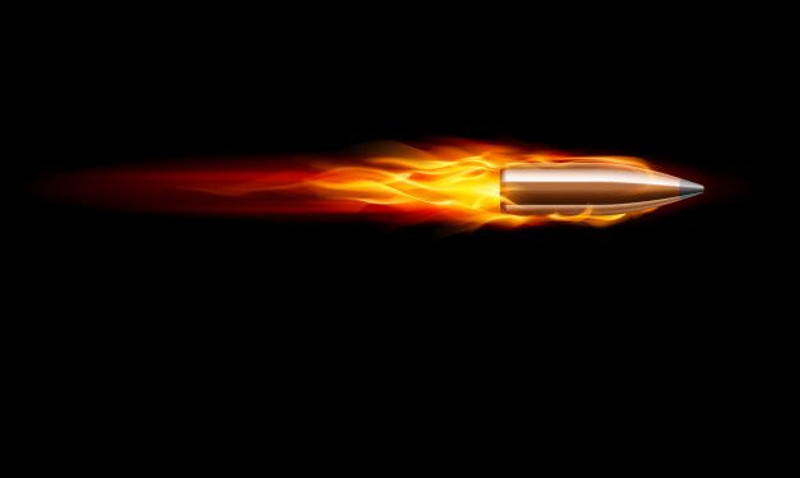The 5.56×45mm NATO (commonly pronounced "five-five-six NATO") is a rimless, bottlenecked intermediate rifle cartridge standardized by NATO in 1980. Developed by FN Herstal in Belgium, it evolved from the .223 Remington and became the second standard service rifle cartridge adopted by NATO forces, offering a lightweight, high-velocity alternative to the 7.62×51mm NATO round.
Quick Specifications
- Origin: Belgium
- Designed by: FN Herstal
- Service Use: 1980–present
- Used by: NATO, Japan, South Korea, Taiwan, Israel, Australia, and other allies
- Parent Case: .223 Remington (M193)
- Case Type: Rimless, tapered, bottleneck
- Bullet Diameter: 5.70 mm (0.224 in)
- Case Length: 44.70 mm (1.760 in)
- Overall Length: 57.40 mm (2.260 in)
- Rifling Twist: 1:7 or 1:9
- Max Pressure (NATO EPVAT): 430 MPa (62,366 psi)
- Common Variants: SS109 (M855), L110 (tracer), SS111
Ballistic Performance (from 20" Barrel)
| Bullet Type | Mass | Velocity | Energy |
|---|---|---|---|
| XM193 FMJBT | 55 gr (3.56 g) | 3,260 fps (993 m/s) | 1,294 ft⋅lbf (1,755 J) |
| M855 FMJBT (SS109) | 62 gr (4.0 g) | 3,110 fps (948 m/s) | 1,325 ft⋅lbf (1,797 J) |
| M855A1 FMJBT | 62 gr (4.0 g) | 3,150 fps (961 m/s) | 1,362 ft⋅lbf (1,847 J) |
| DM11 FMJBT | 63 gr (4.1 g) | 2,810 fps (856 m/s) | 1,325 ft⋅lbf (1,796 J) |
Historical Background
Origins and Early Development
The 5.56 NATO traces its lineage to the .223 Remington, developed in the late 1950s during the U.S. Army's Small Caliber High Velocity (SCHV) program. This program aimed to create a lightweight, high-speed cartridge paired with a lightweight rifle. The AR-15, developed by Eugene Stoner of Armalite, and the .223 Remington cartridge (initially called .222 Special), were designed in tandem.
Key performance requirements included:
- Penetration of a steel helmet at 500 yards
- Supersonic velocity beyond 500 yards
- Lightweight rifle design (~6 lbs)
- Select-fire capability
- M2 Ball-like performance (30-06) at extended range
Remington finalized the .223 Remington in 1959. Its performance during U.S. military trials impressed decision-makers, particularly in the Air Force, leading to the eventual adoption of the AR-15 and the cartridge as the M193.
From .223 Remington to 5.56 NATO
Although similar, the 5.56×45mm NATO is not identical to the .223 Remington. In the 1970s, NATO sought a smaller-caliber replacement for the 7.62×51mm NATO. FN Herstal developed the SS109, a 62-grain FMJ round with a steel tip and superior long-range performance due to better ballistic coefficients.
In 1980, NATO formally adopted the SS109 as the 5.56×45mm NATO standard under STANAG 4172. It became known as the M855 in U.S. service. A twist rate of 1:7 was required to stabilize the longer tracer projectiles (L110), while 1:9 was sufficient for standard ball rounds.
Advantages of 5.56 NATO
- Lightweight: Allows soldiers to carry more rounds than 7.62 NATO with the same load.
- High Velocity: Offers flat trajectories and effective engagement at extended ranges.
- Low Recoil: Enhances control during automatic fire and improves accuracy.
- Penetration: Capable of penetrating steel helmets and light barriers at distance.
Legacy and Modern Use
The 5.56×45mm NATO became the foundation of modern military rifle cartridges. Its adoption influenced global small arms design, leading to lighter rifles, improved capacity magazines, and greater logistical efficiency.
Today, it remains the primary caliber for NATO-standard service rifles, carbines, and light machine guns, including the M16, M4, FN SCAR, Steyr AUG, and others.

